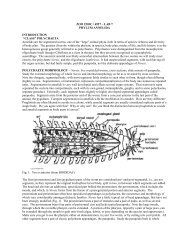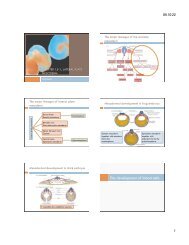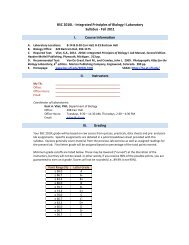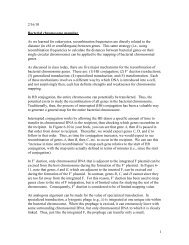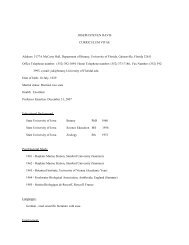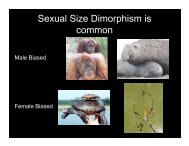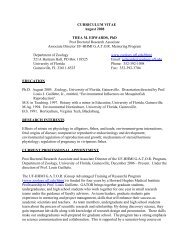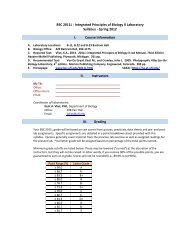BSC 2011L - Department of Biology - University of Florida
BSC 2011L - Department of Biology - University of Florida
BSC 2011L - Department of Biology - University of Florida
- No tags were found...
Create successful ePaper yourself
Turn your PDF publications into a flip-book with our unique Google optimized e-Paper software.
<strong>BSC</strong> <strong>2011L</strong> ‐ Integrated Principles <strong>of</strong> <strong>Biology</strong> II LaboratorySyllabus ‐ Fall 2011I. Course InformationA. Laboratory Locations: B‐11, B‐22 and B‐23 Bartram HallB. <strong>Biology</strong> Office: 220 Bartram Hall, 392‐1175C. Required Text: Vliet, K.A., 2012. <strong>2011L</strong>: Integrated Principles <strong>of</strong> <strong>Biology</strong> II Lab Manual, SecondEdition. Hayden‐McNeil Publishing, Plymouth, Michigan. 261 pp.D. Recommended Text: Van De Graaf, Kent M., and Crawley, John L. 2009. Photographic Atlas for the<strong>Biology</strong> Laboratory, 6 th edition. Morton Publishing Company, Englewood, Colorado. 280 pp.E. Homepage: www.bsc.ufl.edu/<strong>2011L</strong>.html SAKAI: https://lss.at.ufl.edu/II.InstructorsMy TA:Office:Office Hours:Email:________________________________________________________________________________________________________________________________________________________________________Coordinator <strong>of</strong> Laboratories:Kent A. Vliet, PhD, <strong>Department</strong> <strong>of</strong> <strong>Biology</strong>Office: 208 Carr HallOffice Hours: Tuesdays, 9:30 – 11:30 AM; Thursdays, 2:30 – 4:30 PMEmail: kvliet@ufl.eduIII.GradingYour <strong>BSC</strong> <strong>2011L</strong> grade will be based on raw scores from quizzes, practicals, data sheets and pre‐ and postlabassignments. Specific assignments are detailed in a point breakdown sheet provided with thissyllabus. Quizzes generally cover material from the previous lab exercise as well as assigned readings forthe present lab. Final letter grade will be assigned based on percentage <strong>of</strong> the total points earned.Minimum grade cut<strong>of</strong>fs are listed below. These may be lowered ("curved") at the discretion <strong>of</strong> theinstructors, but they will not be raised. In other words, if you receive 90% <strong>of</strong> the possible points, you areguaranteed to earn an A grade. Scores will not be rounded (i.e., 89.9% is not 90%).Point Range (%) Letter Grade≥ 90.0A≥ 86.7 A‐≥ 83.3 B+≥ 80.0B≥ 76.7 B‐≥ 73.3 C+≥ 70.0C≥ 66.7 C‐≥ 63.3 D+≥ 60.0D≥ 56.7 D‐< 56.7 E
safekeeping and (2) hand in the original to the staff <strong>of</strong> the departmental <strong>of</strong>fice (220 Bartram Hall) duringregular <strong>of</strong>fice hours (8 a.m.‐ 4 p.m.).D. Late workLate work will be penalized 10% <strong>of</strong> the total points per day (weekends, i.e., Friday to Monday, are countedas two days and U.F.‐recognized holidays are not counted). NOTE: The weekends preceding and followingthe Semester Break holidays will be counted.E. ParticipationStudents may be allowed to turn in assignments on which they did not participate in the collection <strong>of</strong>data, at the discretion <strong>of</strong> the lab instructor. These assignments will be penalized 20% <strong>of</strong> the points.F. Lab cleanlinessNo food or drink is permitted in the labs and students are expected to leave the lab as clean and orderlyas it was when they arrived for class. NOTE: All scraps <strong>of</strong> paper, paper towels, broken cover slips andslides, masking tape, and any other trash must be properly disposed <strong>of</strong> by the students themselves.G. Lab attireStudents are not allowed to wear sandals or open‐toed shoes in the laboratories.VIII.Academic HonestyAll students registered at the <strong>University</strong> <strong>of</strong> <strong>Florida</strong> have agreed to comply with the following statement:“I understand that the <strong>University</strong> <strong>of</strong> <strong>Florida</strong> expects its students to be honest in all their academic work. Iagree to adhere to this commitment to academic honesty and understand that my failure to comply withthis commitment may result in disciplinary action up to and including expulsion from the <strong>University</strong>.”In addition, on all work submitted for credit the following pledge is either required or implied:“On my honor I have neither given nor received unauthorized aid in doing this assignment.”If you witness any instances <strong>of</strong> academic dishonesty in this class, please notify the instructor or contactthe Student Honor Court (392‐1631) or Cheating Hotline (392‐6999). For additional information onAcademic Honesty, please refer to the <strong>University</strong> <strong>of</strong> <strong>Florida</strong> Academic Honesty Guidelines at:http://www.dso.ufl.edu/judicial/procedures/academicguide.html.IX.Accommodations for Students with DisabilitiesStudents who will require a classroom accommodation for a disability must contact the Dean <strong>of</strong> StudentsOffice <strong>of</strong> Disability Resources, in Peabody 202 (phone: 352‐392‐1261). Please see the <strong>University</strong> <strong>of</strong> <strong>Florida</strong>Disability Resources website for more information at: http://www.dso.ufl.edu/drp/services/. Note thatthe student should provide documentation <strong>of</strong> a requirement for accommodation by the second week <strong>of</strong>labs. No accommodations are available to students who lack this documentation. It is the policy <strong>of</strong> the<strong>University</strong> <strong>of</strong> <strong>Florida</strong> that the student, not the instructor, is responsible for arranging accommodationswhen needed. Once notification is complete, the Dean <strong>of</strong> Students Office <strong>of</strong> Disability Resources will workwith the instructor to accommodate the student.X. Counseling CenterMany students experience test anxiety and other stress related problems. “A Self Help Guide forStudents” is available through the Counseling Center (301 Peabody Hall, 392‐1575) and at their web site:http://www.counsel.ufl.edu/.
XI.Laboratory ScheduleLaboratory topics and reading assignments for this course are listed below. This is a tentative schedule;the dates and coverage <strong>of</strong> specific topics are subject to change.Week Week <strong>of</strong> Laboratory Topic Reading Assignment1 22 Aug **** NO LABS ****2 29 Aug Introduction; Deuterostomes/ Cladistics Chapters 1 & 23 5 Sept **** NO LABS ****4 12 Sept Fetal Pig DissectionChapters 3 and 4*Bring your dissection kits*5 19 Sept Sensory Physiology / Library Exercise Chapter 56 26 Sept Photosynthesis Chapter 67 3 Oct Plant Diversity Chapter 78 10 Oct Plant Anatomy Chapter 89 17 Oct Spatial Relations / Statistics Chapters 9 and 1110 24 Oct Population Ecology / Plan project Chapter 10 and 12 (pp. 203‐204)11 31 Oct **** NO LABS ****12 7 Nov **** NO LABS ****13 14 Nov Species Interactions Chapter 12 and Appendix A14 21 Nov **** NO LABS ****15 28 Nov Biodiversity Chapter 1316 5 Dec **** NO LABS ****
XII.Laboratory Assignment and Point Breakdown SheetWEEK ASSIGNMENTS POINTS1 **** NO LABS THIS FIRST WEEK OF SCHOOL****2 Chordate Classification: Complete the cladistics worksheet on pp. 27‐33). ___/133 **** NO LABS ****4 Fetal Pig (Prelab): Complete the fetal pig prelab activity (p. 53) before coming to lab. ___/2LAB PRACTICAL 1___/10Reproductive System: Complete the work sheet on pp. 67‐68.___/55 Sensory Physiology (Prelab): Complete the sensory physiology prelab assignment onpp. 77‐80 before coming to lab.___/10LAB PRACTICAL 2___/10Sensory Physiology (Data): Complete the data sheet on pp. 81‐82.___/5Library Exercise: Complete a work sheet on pp. 83‐86. This will be due at thebeginning <strong>of</strong> the following lab.___/56 QUIZ 1 ___/10Photosynthesis (Data): Use the data you collect in lab to complete thePhotosynthesis data sheet (pp. 99‐100). Keep this to use to complete the postlabactivity and hand in with that assignment at the beginning <strong>of</strong> the next lab.___/15Photosynthesis (Postlab): Complete the postlab activity (p. 109) before coming to thenext lab.___/107 QUIZ 2 ___/10Plant Cladistics (Matrix): Complete the character state matrix on pp. 133‐135 <strong>of</strong> yourmanual.___/58 LAB PRACTICAL 3 ___/10Plant Cladistics (Tree): Complete the data sheet on pp. 155‐156 <strong>of</strong> your lab manual. ___/59 Spatial Relations (Prelab): Complete the prelab activities (pp. 191‐192) beforecoming to lab.___/10LAB PRACTICAL 4___/10Spatial Relations (Data): Prepare a statistical analysis and discussion <strong>of</strong> the results <strong>of</strong>each <strong>of</strong> the three spatial tests (pp. 193‐196).___/1510 QUIZ 3 ___/10Population Ecology (Prelab): Complete the prelab assignment (pp. 169) prior tocoming to lab.___/5Population Ecology (Data): Complete the data sheet provided by your instructor. ___/5Species Interactions (Planning): Complete the planning exercise for your SpeciesInteraction project on pp. 203‐204.___/5Population Ecology (Postlab): Complete the Maximum Sustainable Yield activity (pp.179‐181) before the next lab. ___/1011 **** NO LABS ****12 **** NO LABS ****13 Species Interactions (Prelab): Read the assigned news article and answer questions(pp. 205‐206) before coming to lab.___/10QUIZ 4___/10Species Interactions (Data Collection): Complete the datasheet provided by your TA. ___/15Species Interactions (Postlab): Complete the postlab activity provided by your TAbefore coming to the next lab.___/1014 **** NO LABS ****15 Biodiversity (Prelab): Complete the prelab assignment on p. 213‐214 before lab. ___/5Biodiversity (Data): Complete the data sheet on pp. 215‐218 in your lab manual. ___/10TOTAL POINTS: ___/255
XIII.<strong>BSC</strong> Laboratory SafetyWork in the <strong>Biology</strong> laboratory may expose students to inherently dangerous activities. Students in the<strong>BSC</strong> laboratories may be exposed to chemicals (e.g., formaldehyde, organic solvents, acids, and other causticchemicals), chemical fumes, laboratory equipment and supplies (e.g., scalpels, razor blades, glass slides, coverslips,and electrical equipment), toxic or irritating properties <strong>of</strong> living and dead animals, and other materials necessary tolaboratory activities. Other possible hazards include broken glass on the floor or counters, combustible materials,and slippery spills.1. Smoking, eating, and drinking are expressly forbidden and NOT allowed in the laboratory.2. Locate the placement <strong>of</strong> safety equipment and supplies in the laboratory: safety shower, eye washstation, fire extinguisher, and first aid kit. Memorize these locations. You should understand the use <strong>of</strong>this equipment. Also note the locations <strong>of</strong> exits. Each laboratory has a chemical exposure manual. Theseinclude material safety data sheets on all hazardous chemicals or compounds to which you might beexposed in the <strong>BSC</strong> laboratory.3. Students should follow instructions carefully, especially when hazardous conditions occur or hazardousmaterials are being used.4. Students should dress appropriately in the lab. Gloves and protective aprons will be made available in thelabs. Students may elect to supply their own gloves and protective aprons or laboratory coats. Onlyshoes that provide complete foot covering are allowed in the lab.5. You should be familiar with fire procedures. Leave the building immediately should a major fire occur or ifthe fire alarm sounds. Notify the appropriate authorities ‐‐ don't assume someone else remembered todo it. Meet with other students and your instructor outside the building before leaving so that anaccurate headcount may be made.6. The safe use <strong>of</strong> specific equipment and tools (e.g., microscopes, slides, scalpels, and pipettes) will bedemonstrated by the instructor during the laboratory sessions. Be sure you understand this usage andask questions if you do not.7. Never pipette by mouth. Always use a suction bulb or pipette aid.8. Notify your T.A. IMMEDIATELY <strong>of</strong> any spills, breakages, or equipment malfunction.9. Students should report all hazardous conditions to the instructor immediately.10. All organisms, living or dead, should be treated with care and respect. Avoid direct handling whenpossible.11. Students should clean up any supplies used and should return materials where they belong as instructed.Any material spilled should be cleaned appropriately. Report any hazardous spills or breakages.12. Broken glass and sharp metal waste should be placed only in those receptacles marked for such disposal ‐‐do not put these materials in normal trash receptacles.13. Work areas must be left clean and dry prior to leaving the lab. Chemicals and reagents must be returnedto their proper places.14. You should always wash your hands before leaving the laboratory, even if you have not knowingly come incontact with any chemicals or biological fluids.





